The OPA Twenty-Fourth Annual National Exhibition in St. Augustine is showcasing several of today’s most successful artists. Expect their demos to be motivating. Demos persuade us to experiment, to change, and to energize our own practice. Further, they teach us new ways to think and see, modify our techniques, and remind us of methods we may have forgotten or never learned. Just breathing new air sometimes, being inspired by accomplished and like-minded artists helps move us to reach for the next level.
Make it your mission to discover a few of their secrets. Look for those “ah-has” gleaned from off-handed suggestions, quick strokes of cadmium, or flying jokes.
What to Expect:
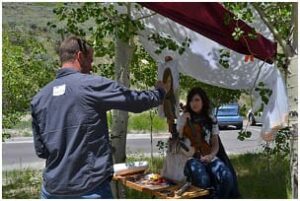 Friday May 1st – 10: 00 a.m. – Noon
Friday May 1st – 10: 00 a.m. – NoonAlbin Veselka OPA: Portrait from Life
Albin plans to paint an oil portrait sketch from life. In describing what motivates him Albin says, “I paint because I am constantly enthralled with what the visual world offers. I try to reflect what that feels like to me through my art in as honest a way that I can.” Albin wants to share with us a training tool he calls “squint and believe”; more on that at the demo.
Takeaway tip: “In the work I want to create, there is a crucial duality of representing accurately and saying something compelling that is my own,” says Albin. “I think the best way to find the balance between those two ideas is painting from life constantly under the limitations of time that necessitates selectively eliminating the superfluous. Painting from life makes sure your reference is as accurate as possible and having time limits requires you to choose what is important to you and what isn’t. Another important step that helps you to insert yourself into your work is to rework the painting later without any reference; this further imposes your intent on the painting.”
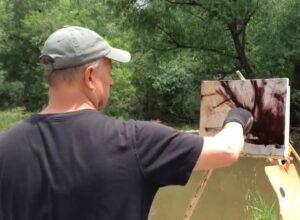 Friday May 1st – 10: 00 a.m. – Noon
Friday May 1st – 10: 00 a.m. – NoonMarc Hanson OPA: Landscape Mood
Marc’s landscape demo will show us how he approaches mood and atmosphere. He hopes to offer an insight into the way he handles paint, and says he looks forward to the demo because he loves the interaction while he paints. “I am a landscape artist at the core,” says Marc. “I like to paint the mood of the atmosphere; the emotional side of the landscape.” The visual beauty of the outdoor world drives Marc as an artist. “It’s what trips my trigger and causes me to get out and let that work within me as I paint along. I am addicted to that investigation and to trying to put down on paper or canvas how I react to it.”
Takeaway tip: Marc encourages us all to paint as much as we possibly can from life, and paint with a purpose when we do.
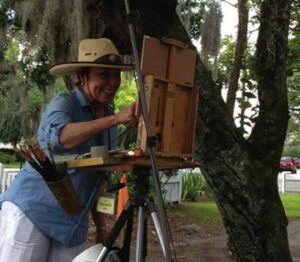 Friday May 1st – 10: 00 a.m. – Noon
Friday May 1st – 10: 00 a.m. – NoonMorgan Samuel Price
Morgan is planning to paint a landscape and interact with the audience about her process. She is known for her dramatic plein air paintings of street scenes and wild places. Local Florida rivers and jungle are favorite subjects. “Just as the artists of the past have shared their knowledge, I too, have always enjoyed sharing mine,” says Morgan. “I am looking forward to the venue.”
Takeaway Tip: The darkest dark in the light is never as dark as the darkest dark in the dark nor is the lightest light in the dark as light as the lightest light in the light!
 Friday May 1st – 10: 00 a.m. – Noon
Friday May 1st – 10: 00 a.m. – NoonDominic Avant
Dominic will paint a figure near the water, working from a photo reference. He’ll discuss how to describe form in the figure and color temperatures, and will answer questions as they are presented. Dominic paints figures in natural moments, and hopes his demo will help viewers gain an insight into his process. “I’d like to show several aspects of my painting,” says Dominic. “For instance, I’ll focus on my color palette, capturing light to describe form on figure, color harmony, and handling water.”
Takeaway Tip: After blocking in the painting, use a direct painting approach and fewer mediums if any.
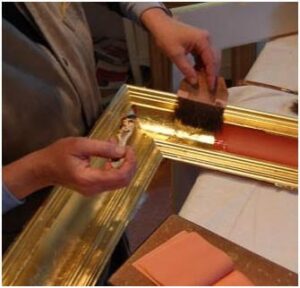 Friday May 1st – 1:00 p.m. to 3:00 p.m.
Friday May 1st – 1:00 p.m. to 3:00 p.m.Barbara Carter: Repairing Frames
An expert in the traditional art of water gilding picture frames, Barbara’s demo will concentrate on repairing frames damaged from gallery wear and tear. “Attendees will hopefully walk away with enough info to do some repairs for themselves,” says Barbara. “I’ll answer questions; give a list of sources, materials and recipes I use; and show them how to touch up frames to make them reusable.” Barbara will show us ways to bring damaged metal and gold leaf frames back to life. She will also show how she places washes on frame panels that are too bright and show techniques of water gilding.
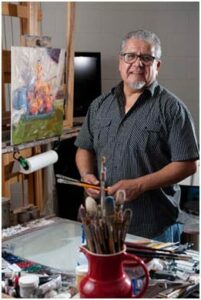 Saturday May 2nd – 3:00 p.m. – 5:30 p.m.
Saturday May 2nd – 3:00 p.m. – 5:30 p.m.Louis Escobedo OPA: Still Life and Light
Louis will create a still life and talk about how he sees color and captures emotion. “The audience often finds the way I construct a painting interesting, especially how it comes together after seeing the effect of light in the painting,” says Louis. He especially encourages us to pay attention to the light on the objects we paint since light is lost when contrasts are forgotten. He also mentions that values are very important and you should consider them before you let color come out to play.
Takeaway tip: “Each painting is a different set of problems. That’s why I’m just as happy whether painting a playful still life of fruit and vegetables, abandoned cars in a field, or a peaceful water scene. Whatever the subject, I’m looking for some element and a way to portray it. There needs to be something emotionally strong in the painting. I strive to evoke an emotional response in both myself and my audience. ”
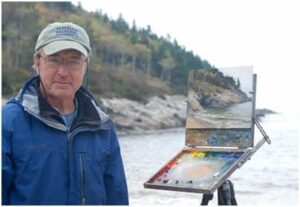 Sunday May 3rd – 9:30 a.m. – Noon
Sunday May 3rd – 9:30 a.m. – NoonDon Demers: Seascape Experience
Known for his maritime themes and seascapes, Don Demers plans to paint a crashing surf. He will show the combination of the structure of a seascape and the strict methodology he employs in painting one. Don says that painting is much more than just the visual. “For all of us who paint, it’s out of some internal need to explain and exalt the world around us. For me, it’s not just about the visuals of the subject. It’s also about trying to capture a human experience. ”
Takeaway tip: “Plan your painting carefully and with clear artistic intention. There is a great technical prerequisite that you are required to have before you can begin to use your artistic voice. You have to know how to do it, before you can know why you’re doing it.”
maryann says
Did Morgan Price mean that the darkest dark in light is lighter than the lightest light in shadow? Or the lightest light in shadow is darker than the darkest dark in light? It is confusing
Judith Berlinger says
Maryann – This one is a brain twister and I’ve heard more than one way to explain it. As a general rule, I’ve been taught, that in a light and shadow painting with one oblique light source, the darkest value in the light must be lighter than the lightest value (the reflective light) in the shadow. I’m sure painters break the rule for effect depending on how the piece reads.